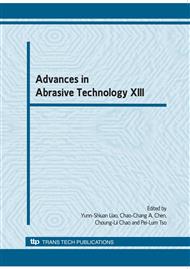p.246
p.252
p.258
p.263
p.271
p.276
p.282
p.289
p.295
Effect of Shear and Thermal Characteristics on Chemical Mechanical Polishing
Abstract:
Chemical mechanical polishing has been widely used to achieve global planarization of wafers. In this paper, an improved designed test rig is used to acquire the signals on chemical mechanical polishing. The shear force and temperature-rise are measured during chemical mechanical polishing process. The polishing temperature is measured by T-type thermocouples screwed behind the polishing interface of the carrier. The shear force is measured by a load transducer mounted on the lever and connected with the polishing head. The parameters including down force, rotation speed, particle size and volume flow rate of slurry are investigated. The experimental results provide a good index to end-point-detection. The theoretical simulation by the average lubrication equation coincides with the experimental results. This study contributes to the understanding of chemical mechanical polishing mechanism.
Info:
Periodical:
Pages:
271-275
Citation:
Online since:
August 2010
Price:
Сopyright:
© 2010 Trans Tech Publications Ltd. All Rights Reserved
Share:
Citation:


